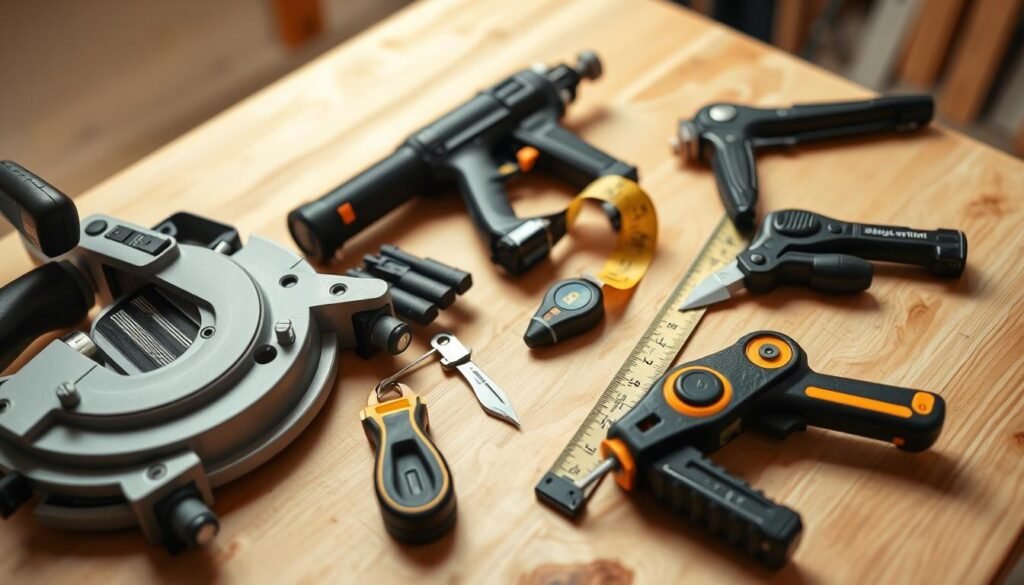Creating a safe and efficient workspace is key for makers and craftsmen. A well-organized workshop is essential for getting work done quickly and safely. By using a few simple techniques, you can make your work area better and safer.
To make your workshop more efficient, it’s not just about having the right tools. It’s also about setting up your space for the best results. Using smart jigs, layouts, and tool hacks can make your work flow smoother. This reduces waste and improves your work’s quality. In this article, we’ll share some tips to make your workspace more efficient and safe.
The Foundation of Workshop Efficiency
To work faster and safer, setting up a good workshop environment is key. This means using several important strategies to keep your workspace productive.
The 5S System Applied to Workshops
The 5S system comes from Japan and focuses on making workspaces better. It has five steps: Sort, Set in order, Shine, Standardize, and Sustain.
Using these steps, workshops can cut down on waste and work better. First, ‘Sort’ means getting rid of things you don’t need. Then, ‘Set in order’ is about organizing what’s left so it’s easy to find.
Creating Workflow Paths That Minimize Movement
Another important part of a good workshop is making paths that save steps. This is done by looking at how work flows and rearranging things. This way, tools and materials are closer together.
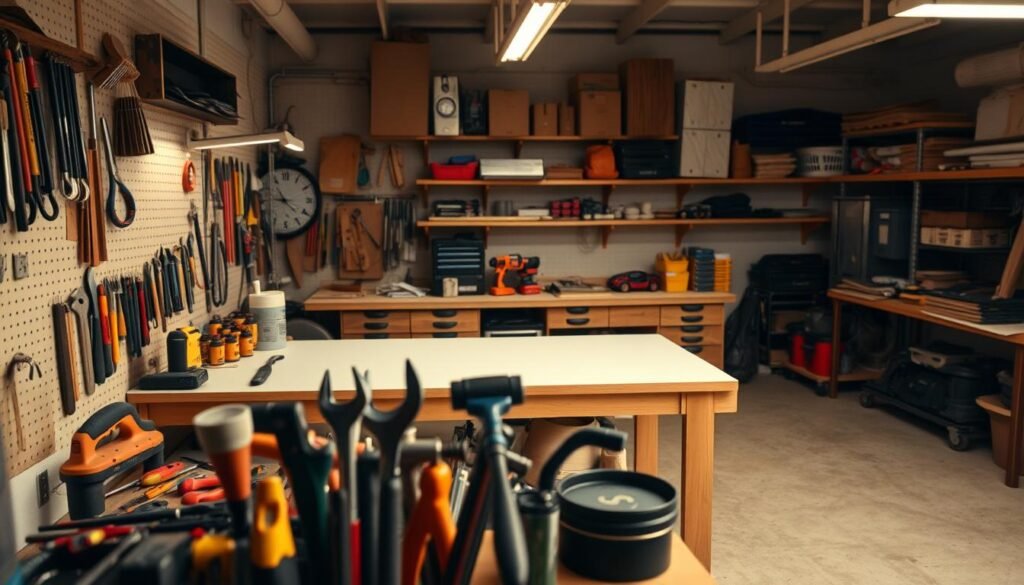
Streamlining work saves time and makes workers less tired. It’s about setting up stations with everything you need right there.
These steps can really make a workshop better. They help finish projects faster and make the workplace safer.
Essential Tool Hacks That Save Time
To work smarter, not harder, you need essential tool hacks. These hacks make your workflow smoother and your workshop more organized and efficient.
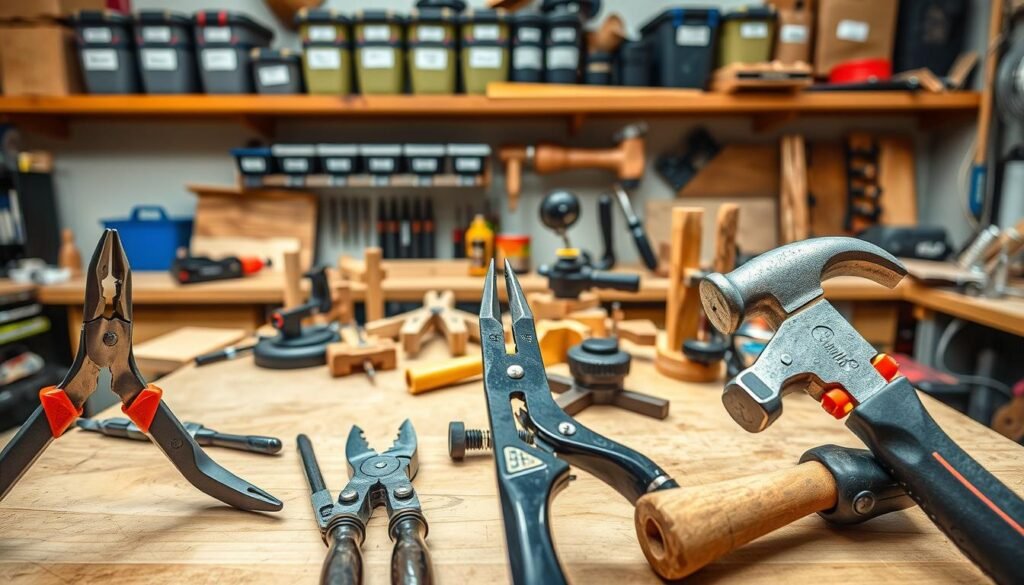
One great tool hack is making DIY magnetic tool strips and holders. Attach magnetic strips to your workshop walls or sides. This keeps your most-used tools close, saving you time looking for them. For more on essential woodworking techniques, check out The Sawdust Man’s website.
Magnetic Parts Bowls for Hardware
Magnetic parts bowls are a smart way to organize hardware. You can stick them to metal surfaces. They’re perfect for storing small parts and screws, so they don’t get lost. This is super helpful for projects with lots of small parts.
Using these tool hacks can really boost your workshop’s efficiency. With tools and parts organized and easy to find, you can work better and faster. This saves you time and makes you more productive.
Simple Workshop Tricks to Work Faster and Safer
Simple tricks can make a big difference in how fast and safe you work. A few easy steps can make your workflow better and lower accident risks.
Tool Handles and Storage Color Matching
Matching tool handles and storage by color is a smart move. It makes finding tools quicker. This way, you can get what you need fast.
It also keeps your workspace tidy. For example, cutting tools could have red handles, and drilling tools blue. Color-coded storage bins and shelves help put tools back where they belong.
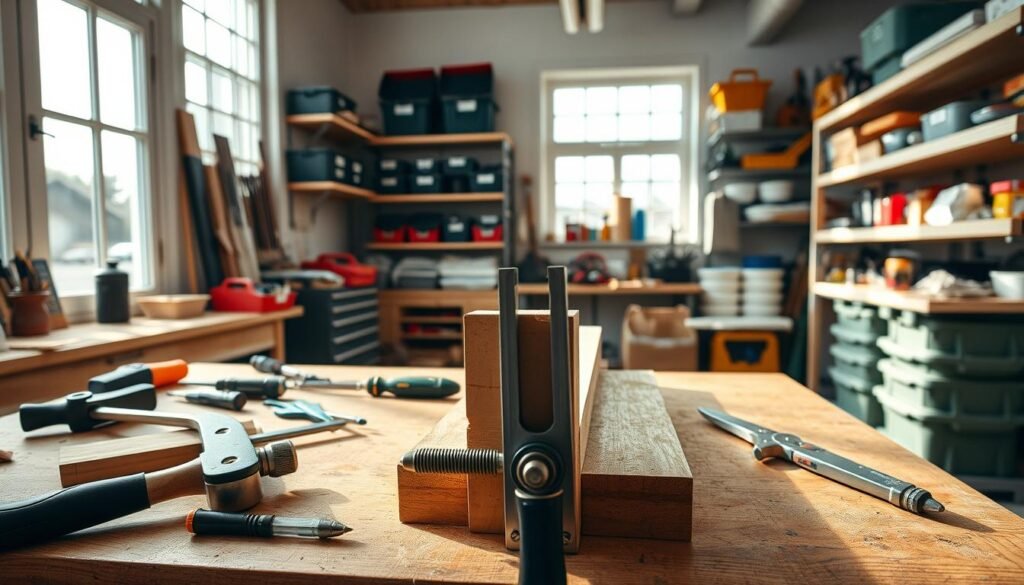
Using colored tape to mark safety zones is another great trick. It clearly shows where it’s safe to be around machinery. This helps avoid accidents.
Yellow or orange tape stands out, making these zones easy to see. This is super helpful in busy workshops where lots of things are happening at once.
Foot Pedal Emergency Switches
Adding foot pedal emergency switches is a key safety step. They let you stop machinery fast in an emergency. This cuts down on injury risks.
Put these switches where they’re easy to reach. This simple step makes your workshop safer. It gives you confidence when working with big machines.
These simple tricks help make your workshop safer and more efficient. They boost your productivity and safety at work.
DIY Jigs and Fixtures That Boost Precision
DIY jigs and fixtures are a big help for woodworkers wanting better precision. They make sure cuts and measurements are accurate. This is key for top-notch woodworking.
Cross-Cut Sled Construction
A cross-cut sled is vital for precise cuts in wood. You’ll need plywood or MDF for the base, two runners for the table saw, and a fence. The base must support your workpiece, and the runners ensure smooth cuts.
Attach the runners to the base, making sure they’re parallel and perpendicular to the fence. The fence should adjust and lock for different sizes. This makes your cuts precise.
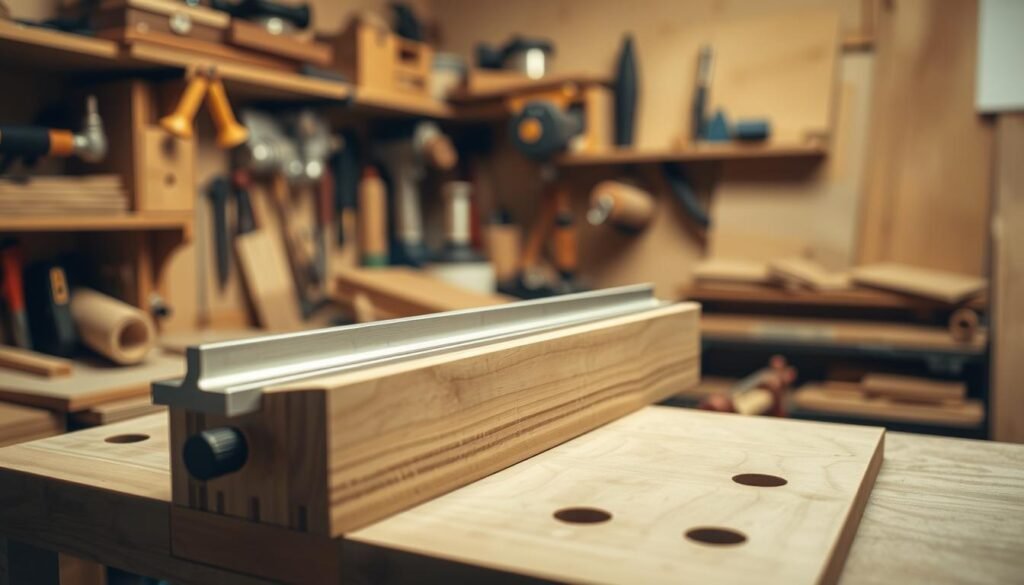
A miter sled is also essential for angled cuts. It has a base, fence, and miter gauge. The miter gauge sets angles, and the fence keeps your workpiece steady.
To make a miter sled, use a strong base and a precise miter gauge. The fence must be tall and adjustable for various angles. This way, you get perfect angled cuts, improving your woodworking.
Adding these DIY jigs and fixtures to your woodworking routine boosts your work’s accuracy and quality. They’re great for both new and seasoned woodworkers, helping you achieve professional results.
Smart Storage Solutions for Better Workflow
In woodworking, having the right tools is just the start. Smart storage keeps your workshop running smoothly. A messy workshop means lost time and less work done. Good storage keeps your space tidy and boosts your work flow.
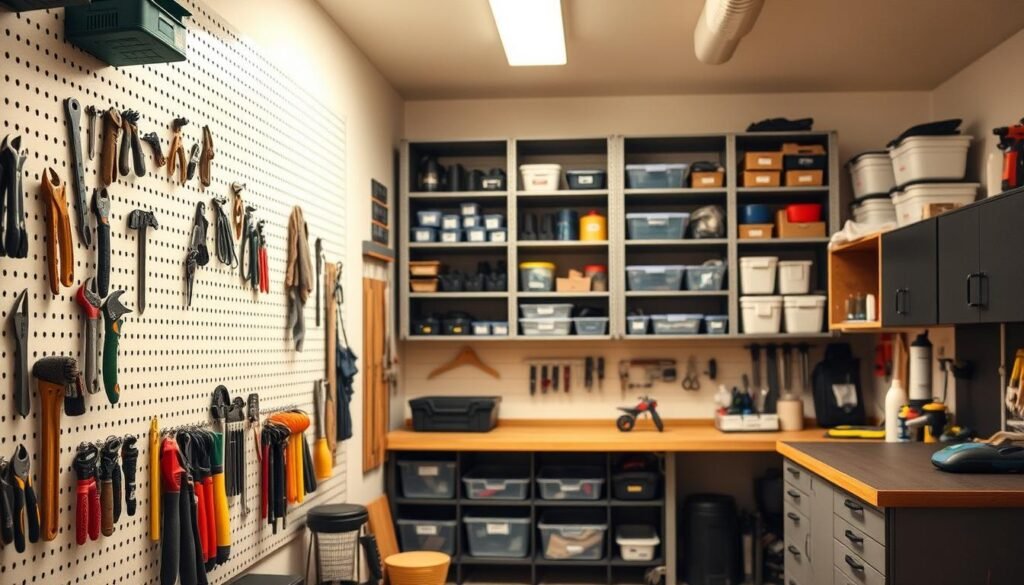
Building modular tool holders is a smart move. These units fit your tools perfectly, making them easy to find.
Building Modular Tool Holders
Modular tool holders are handy and flexible. They grow with your tool collection. Use pegboards or adjustable shelves for a flexible setup.
Small woodworking shops need to save space. Use wall storage, stackable bins, and tool carts. These ideas help keep your shop organized and your workflow smooth.
Safety Shortcuts That Don’t Compromise Protection
Safety should never be traded for speed. But, there are shortcuts that boost both safety and efficiency in the workshop. The right safety measures can greatly lower the chance of accidents and injuries.
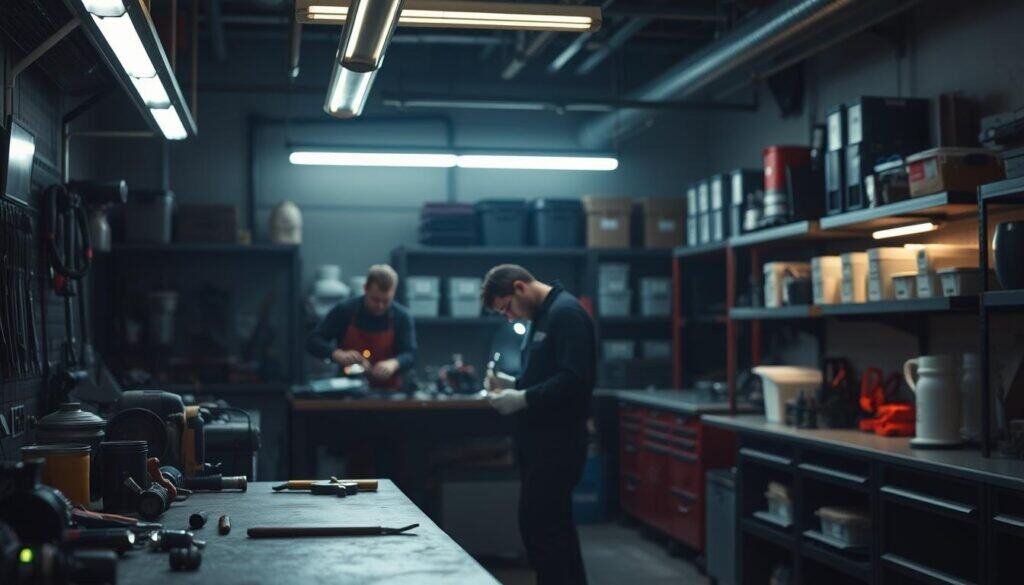
Creating a safety gear checkpoint is a smart move. It’s a spot where workers check their safety gear before starting work. This simple step ensures everyone is ready to work safely.
At this checkpoint, workers check if they have all needed safety gear. This includes gloves, goggles, and ear protection. It prevents accidents and builds a safety-focused culture in the workshop.
Tool-Specific Dust Collection Attachments
Using tool-specific dust collection attachments is another safety shortcut. Power tools can create a lot of dust, which is harmful if breathed in. These attachments capture dust at the source, improving air quality and health safety.
These attachments fit specific power tools, catching dust right where it’s made. This boosts safety and keeps the workshop clean. It also cuts down on slipping hazards and boosts efficiency.
By taking these safety shortcuts, workshops can improve their safety without losing efficiency. It’s about being smart and keeping safety first.
Time-Saving Finishing Techniques
The finishing stage of woodworking projects is key. Using the right techniques can save a lot of time. It’s important to use time-saving finishing techniques to boost workshop efficiency and cut down finishing time.
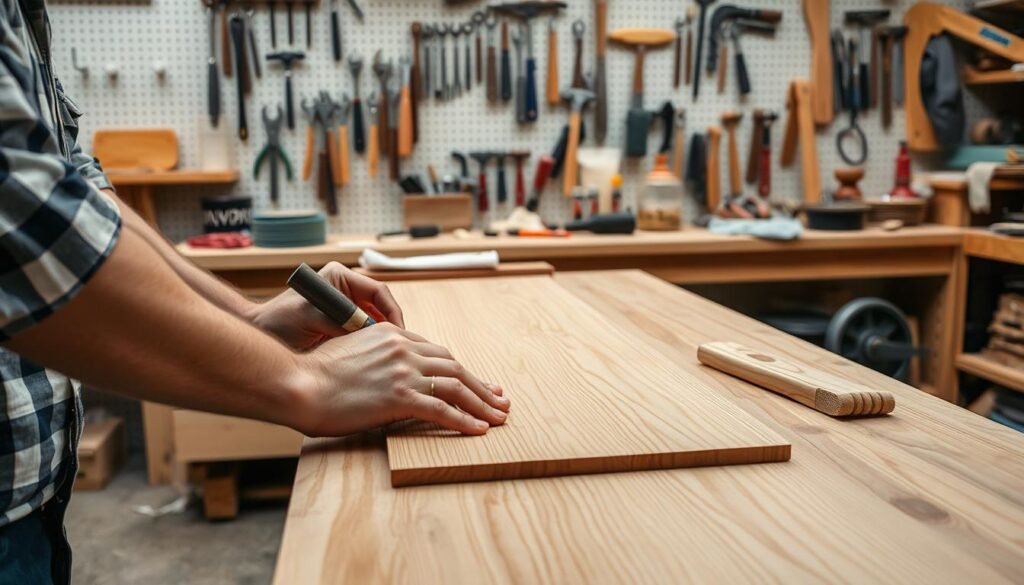
One top way to save time is by using rotating finishing racks. These racks help dry pieces efficiently and prevent damage.
Rotating Finishing Racks
Rotating finishing racks are a big help for woodworkers. They let you dry multiple pieces at once, cutting down drying time and boosting productivity. By rotating the racks, you get even drying and avoid dust on wet finishes.
To get the most from rotating finishing racks, organize your workspace well. Place the racks in a spot with good air flow, away from direct sunlight. Make sure they’re easy to get to. This makes it simpler to move pieces on and off, speeding up your finishing work and making DIY projects easier.
Maintenance Shortcuts for Longer Tool Life
Proper tool maintenance saves money and keeps your workshop safe. Regular care makes sure your tools work well and last longer. We’ll look at some quick maintenance tips to improve your woodworking tools’ life and performance.
5-Minute End-of-Day Cleaning Protocol
Start a simple cleaning routine at the end of each day. Spend just five minutes cleaning your tools. Use a soft brush or cloth to remove dust and debris.
For tools with small parts, compressed air works great. Apply a rust inhibitor to cutting tools to stop corrosion. This daily routine helps prevent wear and keeps your tools in great shape.
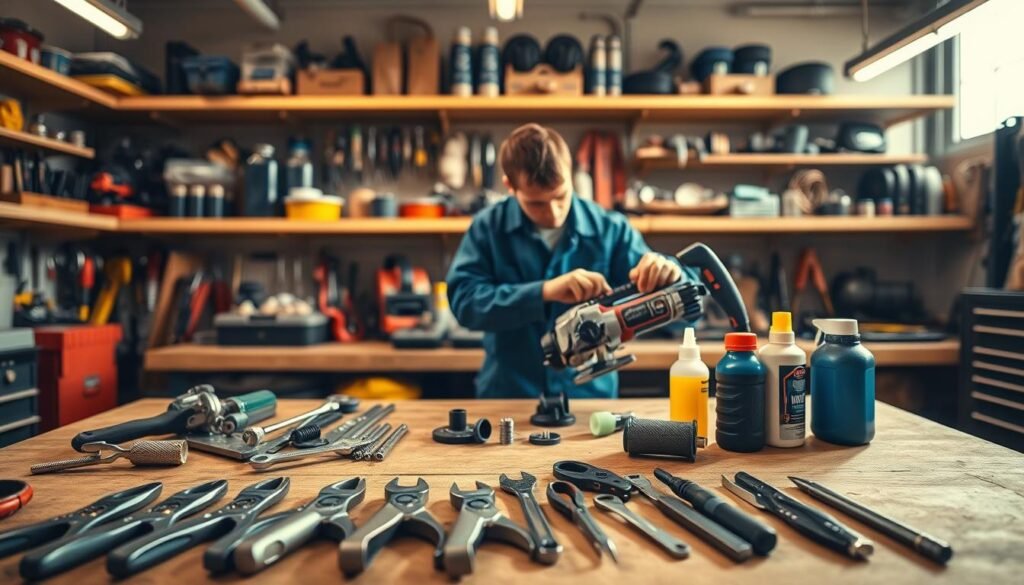
Having a sharpening center is another quick way to improve tool life. It keeps sharpening tools organized and easy to find. This saves time and ensures your tools are sharp and ready.
To set up a sharpening center, pick a good spot in your workshop. Put all your sharpening tools there, like whetstones and sharpening steels. Having everything in one place makes sharpening faster and encourages regular care.
By adding these maintenance shortcuts to your daily routine, you can make your tools last longer. This also boosts their performance and keeps your workshop safer.
Conclusion: Implementing These Workshop Tricks for Long-Term Success
Woodworkers can make their workshops more efficient and productive by using these tricks. Simple changes in tool use, storage, and safety can lead to success in woodworking projects.
Keeping the workshop safe is key to avoiding accidents and working smoothly. Using DIY jigs, smart storage, and quick finishing techniques can increase productivity. This lets woodworkers focus on making high-quality projects.
To succeed in the long run, a well-organized and efficient workshop is essential. Regular upkeep and following safety rules help woodworkers work better and stay safe.

